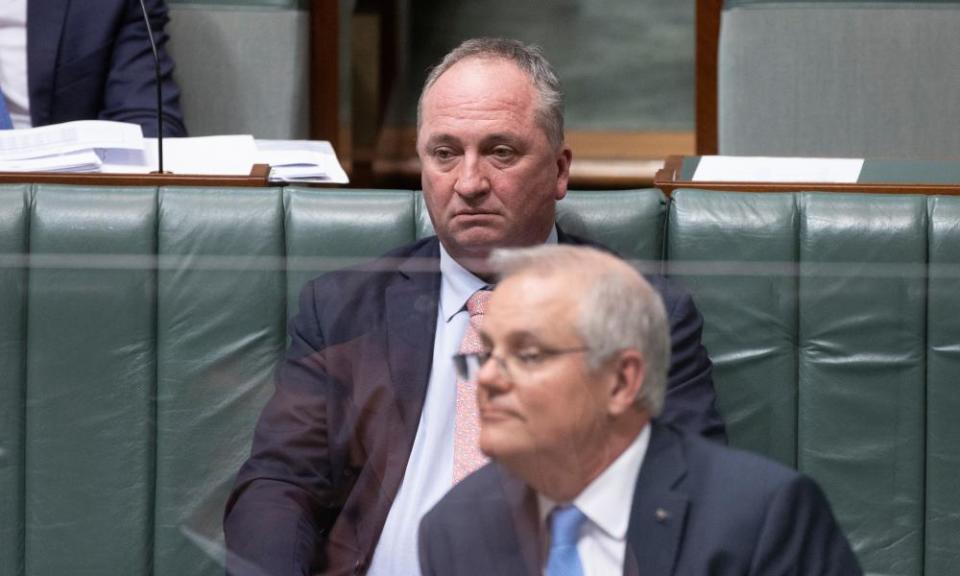Coalition avoids meltdown over emissions target – but at what price?

Barnaby Joyce came back to the leadership of the National party in the middle of the year believing that he was the leader to stop Scott Morrison landing a net zero commitment.
Joyce said as much publicly shortly after regaining the top job. In mid-July, he declared there would be zero chance of the Nationals party room agreeing to net zero.
On Sunday, the Nationals leader found out he was wrong.
In fact, the opposite was true. Joyce was just the stroke of fortune the prime minister needed. He was exactly the Nationals leader Morrison required to get his climate pivot over the line.
Going into Sunday’s crucial meeting, the Nationals’ numbers were said to be nine yes, eight no, and four swing votes.
By the end of of a two-hour partyroom conversation, a majority of colleagues were in favour of the net zero transition, provided Morrison followed through on the various high-level policy undertakings.
There wasn’t a formal vote in the room, but a tally was kept.
Related: Eight years, 20 policies: how Australia’s leaders have fumbled and dithered on climate
Joyce acknowledged the majority position in favour when he spoke at the end of the debate.
According to multiple sources, at that point the deputy prime minister also revealed his own position.
Joyce told his colleagues he was not in favour of net zero.
This is, of course, pretty extraordinary.
What this means is the Nationals leader – Australia’s deputy prime minister – is now fronting a Nationals partyroom decision that he personally doesn’t agree with.
It’s not just Joyce. Two other Nationals ministers – Bridget McKenzie and Keith Pitt – were also serious net zero sceptics, if not outright opponents. (Some say McKenzie was recorded as a no vote on Sunday, although recounts of her remarks to colleagues are hard to follow.)
Shortly after the leader’s contribution, George Christensen (another no to net zero) who dialled in remotely, wearing a T-shirt with “Support Coal” emblazoned on the front, said words to the effect that he would reconsider his position in the government. Matt Canavan, who fought Sunday’s landing point tooth and nail, was also full of fighting words.
So where have we ended up?
Joyce told waiting reporters the Nationals had agreed to a “process” for net zero.
This means Morrison has landed his net zero agreement in time for the Cop26 in Glasgow, provided the prime minister delivers on undertakings set out in a four-page high-level policy document – which at the moment has no dollars spelled out.
Morrison worked over the weekend with Joyce, the agriculture minister, David Littleproud, and the treasurer, Josh Frydenberg, on the shape of an agreement. There is still more work to do.
The Nationals want an extra position in cabinet – which means the return of Pitt (who was half sacked by Joyce when he returned to the leadership). They also want safeguards around regional jobs, and investment in new industries and infrastructure.
The Nationals had wanted Morrison to agree to a safety-valve mechanism where Australia would abandon its net zero commitment if regular reviews about the impact of the transition showed that regional Australians had gone backwards.
But the Liberals are drawing the line at that. The Liberals are happy to have reviews, but not happy to adopt a conditional commitment to net zero.
After all, Morrison told a meeting of the Liberal party room meeting just last week that Australia would go to Cop26 promising a net zero commitment as a nationally determined contribution – not just airy political rhetoric.
If Morrison were forced by the Nationals to walk that undertaking back, the prime minister would face a boilover in his own partyroom.
A number of Liberals wanted Morrison to land a higher emissions reduction target for 2030 as well as the mid-century commitment, but the Nationals vetoed an increase in the medium-term target straight out of the blocks.
As it stands, Morrison will go to Glasgow with a new projection showing Australia will reduce emissions by 2030 by more than the agreed 26 to 28% – but not with a new target, which is what key allies including the United States and the UK wanted Australia to deliver.
While all the frenzied political debate in Australia has hinged around 2050, in Glasgow all the substantive focus will be on 2030 – a reality that amply demonstrates just how Australia stubbornly lags the global reality.
So a deal for net zero is all but done.
Morrison will be relieved that Sunday didn’t end up in total mayhem, with ministerial resignations and the Coalition in meltdown. He’ll be relieved that a project he started shortly after Donald Trump lost the US election remains on track.
The prime minister has told the Nationals he’ll be going to Glasgow on Thursday with his mid-century commitment – come what may.
But Australians will have to wait a couple of days to learn the price of majority Nationals’ support.

 Yahoo Movies
Yahoo Movies 